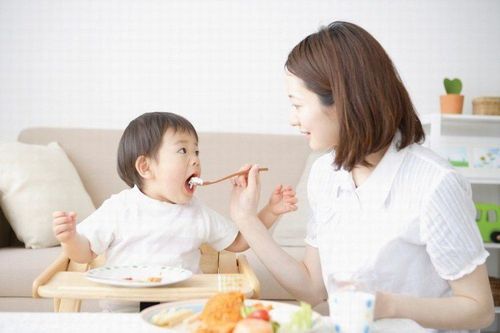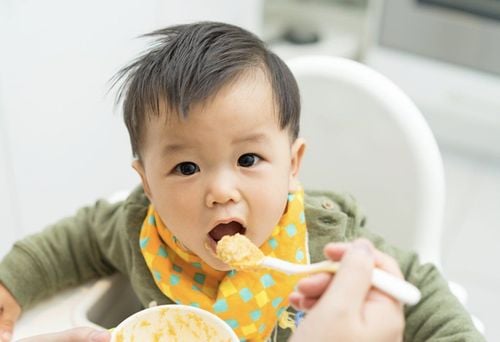This is an automatically translated article.
Can a 15-month-old child eat rice? Many parents have been wondering about this. By this stage, children have grown about 10 teeth and can enjoy biting food. But that is still not enough, because in order to eat rice, it requires children to be able to chew rice and food.
1. Can a 15-month-old child eat rice yet?
When children have molars to crush food, they should give them rice. The front teeth only have the function of biting and tearing food, it cannot crush food, so if you feed your child rice when he has only his front teeth, he will swallow the whole rice. This makes the digestive system work harder, consumes more energy, and slows down weight gain.
The main source of energy for a 15-month-old baby is still milk including breast milk and formula. Weaning meals are mainly aimed at providing substances in milk that have not yet met the child's needs such as iron, zinc, fiber, and fat, and for the baby to gradually get used to solid foods. Therefore, it is not necessary to give the baby rice to eat, but to give the child porridge to help them digest more easily.
15-month-old babies already have about 10 teeth, so sometimes they can eat rice as long as the rice and food are very soft. Amount of food in a meal and how to choose food for babies to eat at this stage:
Rice: Half a cup of rice is cooked soft or add a little water to the rice and then steam it to make the rice softer. Protein-rich foods: Use 30g of fatty meat (fatty bacon) or soft lean fish (such as snakehead, catfish, basa...) or eel, shrimp, egg... Soft vegetable soup with delicious flavors such as yams soup, jute vegetable soup, spinach soup (you need to leave the spinach leaves raw), pumpkin soup, zucchini, gourd soup, tomato soup cooked with eggs. The amount of fat in a meal is from 5 to 10ml, used to prepare baby food. It is best for the whole family to eat the same dishes with the baby to make meal preparation less difficult. At mealtimes, you put rice and food on a multi-compartment tray and feed your baby for 20-30 minutes, if your baby doesn't like to eat anymore, you can give him snacks (cake, milk, yogurt, whey, etc.) .) right after a meal to provide enough energy for the baby.
In addition to 3 main meals, you need to give your baby 550 to 650 ml of milk per day. If your baby gains ≥ 300g in weight and ≥ 1cm in height every month, you're doing very well. If the child does not gain weight, you need to take him to the doctor for more advice.
After 19 months of age, when the baby has at least 16 baby teeth, the baby can get used to pureed rice. After 24 months, children who have about 20 teeth can learn to eat soft rice. From 18 to 24 months old, you can feed your baby 3 main meals a day with crushed rice and porridge.
The mistake that many parents often make is that they often blend the rice very well and then pour the broth in. This will make the child very easily bored and discourage chewing movements in the baby.

Trẻ 15 tháng ăn được cơm chưa là thắc mắc của nhiều phụ huynh
Baby's portion of rice must be softer than adult rice. When cooking normal rice for the whole family, you can select a portion of rice and lightly beat it with a spoon to break the rice grains and then boil them again in the rice cooker. Another way is that you can tilt the rice cooker to one side while cooking, so you will have a slightly more mushy rice for children.
Children's meals always need to have a full range of nutrients, and you should choose foods that your baby likes and prepare appropriately. Protein foods should be cooked soft and cut into small pieces. Vegetable foods need to be cooked soft, beautiful color, rich in fiber and rich in vitamins. Foods rich in fat should be selected according to the child's preferences and family economic conditions.
When preparing food for children, you need to be flexible and flexible in using enough fat in the process of preparing food, in order to meet the needs of children in the first years of life.
A situation that parents often have when feeding their children rice is showing stress when the child does not like to eat rice, only likes to eat instant noodles, vermicelli... If the child does not like to eat rice, you can Feed your baby foods other than rice but still have enough 4 groups of nutrients. For example, if your child likes to eat noodles, you can add eggs, rolls, sausages to the noodles to ensure protein, then give them more vegetables and fruits.
When teaching children to eat rice, you need to patiently coax the child to eat some rice first and then give them the foods they like later to maintain the habit of eating rice. In addition, when the main meal of the child is not rice, you need to add milk, dairy products, snacks... so that the child can receive enough nutrients.
2. What should a 15-month-old child eat?
"What should a 15-month-old child eat?" is the concern of many parents. The 15-month-old baby is still developing rapidly both physically and mentally, so the diet needs to provide enough energy for the child to gain weight and enough nutrients for the baby to be healthy. In terms of the number of meals, the child needs eat 5 meals a day including 3 main meals and 2 snacks, babies still need to continue to breastfeed. If the baby has stopped breastfeeding, you should give the baby more formula, or fresh milk. Snacks should be given to children to eat fruits such as bananas, papayas, sapodilla, mangoes, oranges... and yogurt, cheese... Amount of food during the day to ensure the nutritional needs of the 15-month-old baby Age required:Rice (cooking porridge): 120 - 150 g. Meat (or fish, shrimp...): 100 - 120g, a week should give children 3-4 eggs (both white and yolk). Milk 500ml (if the baby has stopped breastfeeding). Oil (fat): 20 - 30g (equivalent to 4-6 teaspoons of 5 ml). Green vegetables: 50 - 80g. Ripe fruit: 100 - 120g.

Trẻ 15 tháng tuổi nên ăn gì thì cha mẹ cần xem chế độ dinh dưỡng phù hợp với lứa tuổi của trẻ
To help your baby eat deliciously and provide many nutrients, you should prepare it in the following way: Cook a pot of white porridge, then scoop a bowl into the small saucepan at each meal, then add meat (eg. beef, chicken, pork) or fish, shrimp, eggs with green vegetables, cooking oil or fat.
For children to increase height, you should give your baby foods that contain a lot of calcium (such as crab, shrimp, cheese, yogurt) and iron, reasonable zinc supplements (such as meat, eel, heart, milk) sour). Note that along with the diet, you need to increase your baby's outdoor play so that exposure to sunlight helps metabolize vitamin D and absorb calcium better, thereby preventing rickets.
In addition, it is still necessary for children to drink enough water because young children have higher needs than adults (on average 100 ml/kg body weight/day), especially in the hot season, you should give your baby plenty of water. than.
For more nutritional knowledge and child care for each age, parents should regularly visit the website vimec.com and make an appointment with the leading doctors, pediatric and nutrition experts of the National General Hospital. Vinmec when needing advice on children's health.













